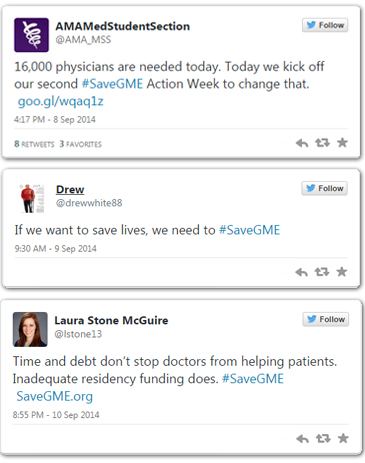 Medical students and trainees took to social media last week, calling for Congress to support graduate medical education (GME) and bringing attention to the impending physician shortage during Save GME Week.
Medical students and trainees took to social media last week, calling for Congress to support graduate medical education (GME) and bringing attention to the impending physician shortage during Save GME Week.
Students and residents used #SaveGME on Facebook and Twitter, posting facts about why more GME positions are crucial for the future of medicine and the health of the nation. Many also leveraged the online advocacy tools at SaveGME.org to contact their lawmakers directly, urging them to save GME.
“A tremendous amount of medical care in the United States is delivered by residents and fellows, and that’s why it’s so important for trainees to participate in Save GME Week,” said Maya Babu, MD, the resident member of the AMA Board of Trustees. “Residents and fellows train in teaching hospitals, which provide a diverse range of critical health care services, including complex trauma care, burn units and neonatal intensive care units. These services are provided round-the-clock, seven days a week and heavily rely on the resident and fellow workforce.”
The weeklong grassroots campaign needs student and resident involvement to be successful, said Sam Mackenzie, a third-year MD/PhD student at Upstate Medical University and a member of the AMA Board of Trustees, on a special Save GME episode of the medical student and trainee podcast Radio Rounds.
“Medical school requires a lot of focus, and I think it can be difficult for students to get their heads out of their books sometimes and participate in some of these bigger picture processes of change going on around them,” said Mackenzie,. “Certainly health care reform comes to mind, but in the more immediate future, students really need to be active on the subject of GME.”
Workforce experts predict a shortage of more than 45,000 primary care and 46,000 specialty physicians in the United States by 2020, and medical schools are producing more graduates to prepare for this expected shortage. At the same time, the number of residency positions has remained capped, meaning some students may not match to training positions, which could exacerbate the shortage.
Meanwhile, physician maldistribution throughout the United States has led to a lack of doctors in underserved areas, both in primary care and in specialties. Mackenzie is planning to specialize in pediatric neurology, and said it can be difficult for patients to see pediatric neurologists.
“At my institution, the waiting time just to see one of these few attending physicians that we have in child neurology is between four to six months,” he said. “There have been some pretty unfortunate barriers to expansion, thanks to a federal cap [on residency positions] … The cap very simply exacerbates the physician maldistribution in this country.”
Check out what students and residents across the country had to say about Save GME Week, and learn more at SaveGME.org.




